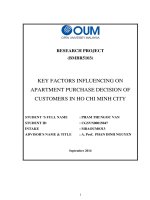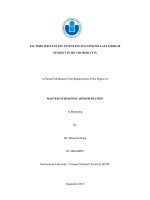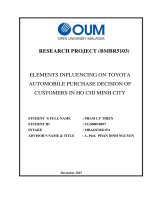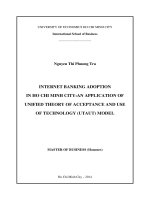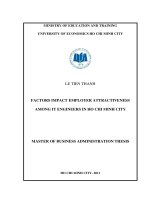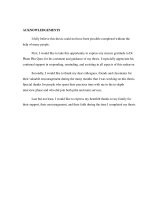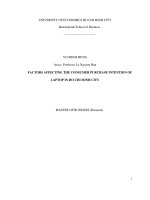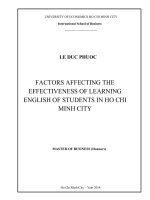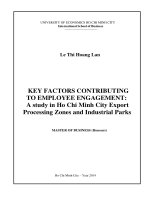Factors influencing credit card use of customers in ho chi minh city an empirical analysis
Bạn đang xem bản rút gọn của tài liệu. Xem và tải ngay bản đầy đủ của tài liệu tại đây (1.03 MB, 75 trang )
ACKNOWLEDGEMENTS
I fully believe this thesis could not have been possible completed without the
help of many people.
First, I would like to take this opportunity to express my sincere gratitude to Dr.
Pham Phu Quoc for his comment and guidance of my thesis. I especially appreciate his
continual support in responding, reminding, and assisting in all aspects of this endeavor.
Secondly, I would like to thank my dear colleagues, friends and classmates for
their valuable encouragement during the many months that I was working on this thesis.
Special thanks for people who spent their precious time with me in the in-depth
interview phase and who did join both pilot and main surveys.
Last but not least, I would like to express my heartfelt thanks to my family for
their support, their encouragement, and their faith during the time I completed my thesis.
ABSTRACT
Credit cards are being used popular nowadays as a hot trendy in society. There are many
credit card providers in the fierce competition to increase number of people use their
products and services. The purpose of this thesis is to examine key factors influencing
customer’s credit card use in Ho Chi Minh City.
To empirically apply the conceptual model and test the hypotheses, data are collected
through a questionnaire involving 118 bank customers who already knew about credit
cards. Data are analyzed using exploratory factor analysis and multiple regression
analysis.
Convenience perceived has been defined as the strongest predictor of credit card use in
Ho Chi Minh City with β = 0.539, followed by compatibility perceived with β = 0.307;
and policies were provided by bank with β = 0.124. However, the findings did not state
the negative relationship that exists between risk barriers and credit card use of
customers in Ho Chi Minh City with ß = -0.037 and p = 0.5380.
Finding the predominant factors (bank policy, convenience and compatibility) which
effect to credit card use can provide credit card providers with valuable insights then
they improve their policy as well as emphasize convenience and compatibility attributes
to instill confidence among consumers and motivate them to use credit cards.
There is very limited previous research on Vietnamese credit card use. Through a multifaceted framework, this study extends the literature on influence of bank policy,
convenience, and compatibility and risk barriers in the context of credit card use among
Vietnamese customers.
Keywords - Credit Card Use, Bank Policy, Convenience, Compatibility, Risk Barriers
TABLE OF CONTENTS
CHAPTER 1: INTRODUCTION ................................................................................................. 1
1.1Research background ................................................................................................................. 1
1.2Research motivation ................................................................................................................... 4
1.3Research objective ...................................................................................................................... 5
1.4Research methodology and research scope .......................................................................... 6
1.5Research contribution................................................................................................................. 7
1.6Research structure ....................................................................................................................... 7
CHAPTER 2: LITERATURE REVIEW .................................................................................... 9
2.2 Bank’s policies .......................................................................................................................... 13
2.3 Convenience .............................................................................................................................. 14
2.5 Risk barriers ............................................................................................................................... 17
2.6 The conceptual model and hypotheses of the research .................................................. 20
CHAPTER 3: RESEARCH METHODOLOGY .................................................................... 22
3.1 Research process ...................................................................................................................... 22
3.1.1 Step 1: Item generation step............................................................................................... 22
3.1.2 Step 2: Pilot study ................................................................................................................. 23
3.1.3 Step 3: Main study ................................................................................................................ 23
3.2 Questionnaire design ............................................................................................................... 25
3.3.1 Sample ..................................................................................................................................... 27
3.3.2 Sampling method .................................................................................................................. 28
3.4 Data analysis method .............................................................................................................. 28
CHAPTER 4: DATA ANALYSIS ............................................................................................. 30
4.1 Respondents’ demographics .................................................................................................. 30
4.2 Reliability Analysis ................................................................................................................. 32
4.3 Exploratory Factor Analysis (EFA) .................................................................................... 34
4.3.1 EFA for variables .................................................................................................................. 34
4.3.2 EFA for Dependent variables ............................................................................................ 37
4.4 Multiple Regression Analysis ............................................................................................... 38
CHAPTER 5: CONCLUSION, IMPLICATIONS, AND LIMITATIONS .................... 47
5.1 Conclusion ................................................................................................................................. 47
5.2 Managerial Implications ......................................................................................................... 47
5.3 Limitations and future research ............................................................................................ 49
REFERENCES ................................................................................................................. 51
APPENDICES.................................................................................................................. 59
APPENDIX A: Questionnaire (English Version) ............................................................ 59
APPENDIX B: Questionnaire (Vietnamese Version) ..................................................... 63
APPENDIX C: Histogram, Normal Regression & Scatter plot of Dependent ................ 67
LIST OF TABLES
Table 2.1 Summary of main research findings on credit card use…………………. 12
Table 3.1 Summarize the reference sources of measurement scale used for each factors
………………………………………………………………………………. 26
Table 3.2 Source of data collection………………………………………………… 28
Table 4.1 Respondents' characteristic………………………………………………. 31
Table 4.2 Reliability Statistics……………………………………………………… 33
Table 4.3: KMO and Bartlett's Test………………………………………………… 34
Table 4.4: Rotated Component Matrix for Independent Variable………………… 35
Table 4.5: Total Variance Explained of Dependent Variables…………………… 36
Table 4.6: Table KMO and Bartlett's Test………………………………………….. 37
Table 4.7: Rotated Component Matrix for Dependent Variable…………………… 37
Table 4.8: Total Variance Explained of Independent Variables…………………… 38
Table 4.9: Casewise Diagnostics…………………………………………………… 39
Table 4.10: Correlations……………………………………………………………. 40
Table 4.11: Model Summary……………………………………………………….. 41
Table 4.12: ANOVA………………………………………………………………... 42
Table 4.13: Coefficients…………………………………………………………….. 42
Table 4.14 Summary of hypotheses testing result………………………………….. 45
LIST OF FINGURES
Figure 2.1: A theoretical model……………………………………………………. 21
Figure 3.1: Research Process……………………………………………………….. 25
CHAPTER 1: INTRODUCTION
This chapter introduces the research background, researches’ motivations,
objectives, methodology and scope; and its contribution.
1.1 Research background
The overview about credit card use in over the world and Vietnam is discussed in
this section.
Credit cards are defined as available money which is used in advance and make
payment later (Mitchell & Mickel, 1999). People around the world enjoy making
payment by credit cards for variety commodities from low to high value such as
electric/water bills, shopping, eating, household commodity, car, house, etc. Besides,
with economic growth, the number of people in the middle income increases together
with the increasing of people gaining bank account. Furthermore, credit card services
and its delivery change a lot with the growing of technology which is considered as the
most important factor (Suoranta, Mattila & Munnukka, 2005). Consequently, there are
more people and businesses are joining in credit card use as advance financial electronic
transactions, then the credit card as a payment method is increasing. As a result, there
are many tough competitions between credit cards providers in getting higher credit card
market share.
Credit card market grow significantly since the first credit cards were introduced
in the 1950s in USA (Durkin, 2000); with increasing number of customers hold credit
cards (Devlin, Worthington & Gerrard, 2007). Credit cards are different with other
payment modes as they are used as long term credit without any collateral at the time
using money (Stavins, 1996, cited by Chakravorti, 2003). Many years ago, bank’s policy
permitted only rich people could apply for credit cards. Step by step, banks lower
1
qualifications for customers applying for new credit cards. The fast growth of economy
in Asian countries has opened more opportunities for customers in those countries
applying credit cards. During the year 2007, credit card use in the Asia Pacific region
stood at $1.3 trillion which was 30 percent of global credit card transactions with Japan
lead the region in total transactions made through credit cards ($209 billion), follows by
South Korea ($203 billion), Australia ($140 billion), Taiwan ($24 billion), then China,
New Zealand and India (KPMG, 2009). Due to the huge growth of credit cards use
among customers in the emerging markets, studying the customer’s credit card use in
those markets is particularly important. Many researchers believe that the rapid
increasing of new middle income customers and advantage technology in emerging
markets are two of the determinants that make these markets become attractive to credit
card providers around the world.
There has been a rapid increase in credit card issuing in Vietnam recently.
Between 2009 and 2011, the number of credit card issuing increases by 198 percent and
1.62 million credit cards are issued at the end of 2012 or 2.4 cards per 100 adults
(Lafferty, 2013). According to The State Bank (cited in Ocean Bank Annual Report,
2014), until end of October of 2013, Vietnam has 52 payment card providers, with
estimated 64 million payment cards; among its credit cards is 3.6%. Compare with the
number 1% which Nielsen Research indicated in 2011 about the number of credit card
users in Vietnam (as cited in Military Bank news, 2011), this is a great development of
credit card use in Vietnam. In addition, the credit cards were used widely after the
Decision of government 291/QD-TTg in 2006 about the plan on non-cash payments for
the period from 2006 to 2010 with an extension until 2020 and Regulations
20/200/NHNN about the issuing, using and supplying services to support card payment.
These decisions play very important roles in promoting non-cash transactions in
Vietnam, by developing infrastructure for non-cash payments and providing incentives
2
for financial institutions to apply more advanced technologies in non-cash payment
systems. Study by Spire Research and Consulting shows that Vietnam has been
beginning to develop into a cashless society and the Vietnam banking and credit card
industry has been developing rapidly over the past 10 years (Spire, 2009). In terms of
the overall card payments channel, the share of cash transactions decreased from 3.4%
in 2009 to 2.7% in 2013, while the share of card transactions increase from 1.5% in
2009 to 3.1% in 2013 (Business Journal, 2014). Dang (2013) states Vietnam credit card
market is expected to have some major changes in the next ten years. Most of wellknown banks worldwide such as Citibank, ANZ, HSBC as well as local banks as such
Vietcombank, Vietinbank, Maritimebank have already implemented many introduction
and promotional programs to increase the awareness of credit cards to customers in
Vietnam.
The challenge of the credit card market in Vietnam is most of the population is
still unbanked and cash still dominates as a main payment method for every day
transactions. Besides, although Vietnam’s urban population growth has averaged around
3.5 percent in recent years; Vietnam still has one of the lowest urbanized rates in
emerging areas of Asia with the large proportion of the population that lives in the
countryside where most of employees are in textiles, agriculture and fisheries fields
(Lafferty, 2013). In 2012, some 20 percent of the population has bank accounts but only
half of these actively use consumer banking services and many consumers, even though
they owned credit or debit cards, still prefer to use cash to make payments for every day
transactions in Vietnam (Lafferty, 2013).
However there are some significant advantages that make Vietnam become a hot
destination for the credit card market. Firstly, Vietnam is one of the fastest growing
economies among the developing countries in Asia and Vietnam's GDP per capita
subsequently rose during the review period from US$1,097.1 in 2009 to US$1,728.4 in
3
2013 (Business Journal, 2014). This is reflected the developments of socio-economic
status. These developments allow the general Vietnamese to have a better quality of life.
Lawrence (2003) claims “Credit cards can be a convenient means of payment, a useful
tool for learning financial responsibility, a resource in case of emergencies, a means to
establishing a good credit history and a way to gain greater access to credit in the
future.” (p. 5). With its convenience and usefulness, credit cards of course are being a
trendy in the country has socio-economic developments as Vietnam. Secondly,
Vietnam’s young population with a median age of 25 with forecast to grow continually
at an annual rate of around 1 percent and is expected to increase to 94.5 million by 2016
offers a good opportunity for continued economic growth at least in the short and
medium terms (Lafferty, 2013). Thirdly, the gradual changing in payment habit in
Vietnam is an excellent condition for credit card market. Especially, under Vietnam’s
trade commitments to the WTO, since January 2011, foreign bank branches in Vietnam
have been treated equally to domestic commercial banks in the areas of credit limits and
credit guarantees and allowed to establish wholly owned subsidiary banks and set up
branches in Vietnam. As a result, several overseas banks have entered the market with
strong competition to local bank in providing services with the latest technologies and
marketing strategies. As a result, people can own credit cards more easily than ever
before and credit card use is more and more popular particularly in big cities such as Ho
Chi Minh or Ha Noi Cities.
1.2 Research motivation
As the discussion in research background, Vietnam possesses many advantages
to be an ideal destination of international credit card providers in near future. According
to Dang (2013), Vietnam is a potential market for credit card providers despite of the
limit of credit card use of credit cards due to many Vietnamese have not get acquainted
with credit card and their lack of understanding of credit cards, as well as a limited card
4
acceptance network. With an average profit per card at $6 in 2011, Vietnam is one of the
world’s least profitable markets for credit cards (Lafferty, 2013) however its young
population, fast-growing middle classes and huge economic growth potential, combined
with improved network infrastructure, point towards a bright future for the Vietnamese
cards market. Anyhow, to be successful in Vietnamese market, such advantages are only
necessary but not sufficient conditions. Besides, not only international but also local
credit card issuers are in aggressive competition to apply marketing strategies and
advertising to increase their market share. Furthermore, understanding what customers’
need expect to the card service providers plays the very important role for the survival
and successful of them. Therefore, it requires credit cards providers to do deliberately
and deeply studies to find out what factors stimulate using credit cards of customers. In
other words, the key factors affected with customers’ credit cards use need to be
examined. With this way, credit card providers can increase their comprehension and
knowledge of consumer behavior towards credit cards which are critical for planning a
long term strategy to win the Vietnam’s payment card market. This is one of the
motivations for author to develop this research.
In addition, to the best knowledge of author, there have been very limited
researches on credit cards in Vietnam. The numerous studies related to credit cards have
been conducted in many countries however there was a few of such researches in
emerging market economies, which includes Vietnam. In addition, due to legal,
structural, cultural, geographical, and socio-economic differences between countries, the
credit card use may to be impacted by variety of factors. This is the second motivation
for author to conduct this study to explore which predominant factors effect to credit
card use in the context of Vietnam, especially for Ho Chi Minh City.
1.3 Research objective
5
The overall objective of this study is to examine key factors effecting to
customer’s credit card usa in Ho Chi Minh City. In specifically, it answers for these
following research questions:
RQ1: Is there a positive relation between bank policy and credit card use of
customers in Ho Chi Minh City?
RQ2: Is there a positive relation between convenience and credit card use of
customers in Ho Chi Minh City?
RQ3: Is there a positive relation between compatibility and credit card use of
customers in Ho Chi Minh City?
RQ4: Is there a positive relation between risk barriers and credit card use of
customers in Ho Chi Minh City?
1.4 Research methodology and research scope
This study uses questionnaire to collect data. The survey questionnaire is
originally developed in English and then translated into Vietnamese with the help of
some English experts. The in-depth interview is conducted to modify the measurement
scale. After the qualitative phase, a quantitative pilot study is conducted in which
individual face to face interviews and online survey are undertaken to test interviewees’
understanding on the contents of questions in this questionnaires as well as to make sure
the properly running of online survey. The final questionnaire is launched in the
following main survey. The questionnaire is sent to respondents by using Google Survey
tool and paper. The next step is analyzing the collected data. The data of this research is
processed using SPSS software with three main stages. First, Cronbach’s Alpha is used
to test the reliability of the measurement scale. Then, the validity of the measurement
scale is checked by Exploratory Factor Analysis (EFA). Finally, simple regression and
6
multiple regressions are used as the main method for investigating the relationships
among factors in the research model.
This thesis focuses on the customers’ credit cards use in Ho Chi Minh City. The
author selects this city for research as it is biggest city with most of citizen are young
and dynamic whose high income and technology skill. The study is designed to gain a
better understanding of the factors influencing use of credit cards. Respondents of this
study are people who live in Ho Chi Minh City and know about credit cards.
1.5 Research contribution
Based on the research results at the end of this study, we contribute practical
insights for credit card marketers in Ho Chi Minh City who are facing many challenges
in the slow growth of credit card market and the aggressive competitions among card
providers in Vietnam. Credit card issuers can get important information from the
findings of this research to design and implement an understanding and appropriate
strategies concerning their target consumers, preferences, credit card application, and
use.
From research perspective, there is very limited previous research on Vietnamese
credit card use. Through a multi-faceted framework, the study extends the literature on
influence of bank policy, convenience, and compatibility and risk barriers in the context
of credit card use among Vietnamese customers to contribute not only the literature in
terms of the factors affecting credit card use in Vietnam, but also serves to motivate
similar studies to be conducted across the emerging market economies to determine
whether the issues reported here are similar or different.
1.6 Research structure
This study is organized into five chapters.
7
It starts with the introduction chapter which presents an outline of this research.
This chapter includes background of the research, motivation for doing research, and
research objectives. Besides, research methodology and scope as well as research
contribution are also mentioned in the first chapter.
Chapter two reviews the theories in the literature of the overview of credit card
and its use and four concepts which the author believe affect to credit card use of
customers in Ho Chi Minh City, including bank’s policy, convenience, compatibility,
and risk barrier. Besides, hypotheses research model are also proposed in this chapter.
Chapter three introduces research methodology used to empirically test the
research model.
Chapter four presents the results of data analysis.
The final chapter discusses summarily the study’s core findings, suggests some
recommendations for business strategy of credit card issuers based on findings and
finally points out some limitations of the research.
8
CHAPTER 2: LITERATURE REVIEW
Chapter 1 provides an outline of this thesis and identified its four research
questions. This chapter reviews the academic literature related to these research
questions and develops hypotheses to test in answering them. The literature overview
about credit card use is introduced in Section 2.1. The theoretical issues and literature
pertaining to RQ1, RQ2, RQ3 and RQ4 are discussed consequently in Section 2.2,
Section 2.3, Section 2.4 and Section 2.5. Finally, research model is proposed with its
constructs and relationship hypothesized among these constructs is also discussed in
Section 2.6.
2.1 Overview on credit card use
As a credit card is still a new product in Vietnam, it is necessary to start with a
study whether or not the bank customers know about credit cards and if so, how their
behavior to credit card use. Credit card use in this study comprises use a credit card
regularly, use a credit card for only specific purchase, like to use a credit card and not
prefer to make payment by cash and thinking of applying for a new credit card (Khare et
al., 2011)
This section will discussed about credit card’s working mechanism and
researches on credit card use in over the world.
The development of high technology hasten the increasing of credit cards
(Suoranta, Mattila, and Munnukka, 2005), with the creation of technical services which
allows operating of service at a global level, based on telecommunications and
information technologies. Phau and Woo (2008) state that the advancement of
technology has made credit card is considered as a convenient mode of transaction.
Credit card symbolizes global reach (people can buy things they want online and have
9
them shipped to their countries), comfortable lifestyle, and a sense of achievement
(Khare et al., 2011).
Following is the illustration of credit cards’ working mechanism.
Source: International Journal of Service Science, Management, Engineering, and
Technology (Varaprasad, Chandran, Sridharan & Unnithan, 2013).
From the mechanism, easily to see that customer, merchant, network and bank
are all equally responsible for a smooth credit card transaction. In Vietnam, Visa and
MasterCard are the main players in credit cards who provide the network (Lafferty,
2013).
Several researches are conducted to study many constructs related to credit card
use. Consumer perception and attitude towards credit card use in Pakistan (Ahmed,
Amunullah, & Hamid, 2009), consumers’ credit card use behavior in Malaysia (Ahmed,
10
Ismail, Sohail, Tabsh & Alias, 2010), the use and holding patterns of consumers in
America (Delner & Katzenstein, 1994); some scholars present their findings from
Middle East focusing on correlates of credit card acceptance (Kaynak, Kucukemiroglu
& Ozmen, 1995); some researchers suggest to credit card companies for educating
students about credit card use (Austin & Phillips, 2001); the use of credit cards and
consumers’ attitudes (Durkin, 2000), some studious researchers developed a model
using fashion orientation, credit card use, and compulsive buying (Park & Burns, 2005).
Customers of different cultures have different views on the use of credit cards (Khare et
al., 2011). Chan (1997) studies the demographic and attitudinal differences between
active and inactive cardholders in Hong Kong. The Wickramasinghe and Gurugamage
(2009) try to understand the use patterns of credit cards in Sri Lanka and they find credit
cards are used major because customers can purchase products on credit cards regularly;
it symbolizes status, and it is used for short-term funding. Chinese households are more
likely to use the credit facility for the purchase of consumer goods (Farrell, Gersch &
Stephenson, 2006). Use patterns effect to Singapore credit cardholders (Gan et al. 2008).
Factors affecting credit card use in India (Khare et al., 2011). Lee and Kwon (2002)
study about consumers’ use of credit cards: Store credit card use as an alternative
payment and financing medium. Worthington et al. (2007) in their study find credit
cards are used for travel and entertainment in China. Besides, several studies are
examined use patterns, age, gender and income influences on credit card ownership, and
relationship of attitudes towards money with use of credit cards.
11
Table 2.1: Summary of main research findings on credit card use
Reseacher
Akin et al. (2010)
Country
Turkey
Findings
Benefits are offered by banks through credit cards which are
considered as a “bundle” of services
Gan et al. (2006)
Teoh et al. (2013)
Singapore
Malaysia
Chakravorti
(2003)
America
Low interest rate and absence of annual fees
Benefits given by the bank and payment policies have
significant influence on credit card holder’s spending
behavior/Banks increase the number of credit card holders
dramatically by policies
Many banks offer different incentives in order to attract
customers to apply for credit cards
Khare et al, 2013
India
Meidan and
Davos (1994)
Maysami and
Williams (2002)
Ahmed et al.
(2010)
Greece
Malaysia
Convenience and security are elements which credit cards
offer are most important for women. Life style has an
influence in spending attitude when using credit card
Worthington et
al. (2007)
Park and Burns
(2005)
China
Credit cards are used for travel and entertainment
South
Korea
Fashion orientation as a main predictor to credit card use
Nga et al. (2011)
Malaysia
Materialism and compulsive buying behavior and their
influence on credit card use
Lin (2011)
Tainwan
Compatible with consumers lifestyle and preferences
Bernthal et al.
(2005)
Chemingui and
Lallouna (2013)
Luarn and Lin
(2005)
Laukkanen et al.
(2007)
Khalid et al.
(2013)
Singapore
Credit cards are considered as convenience in financial
transactions.
Convenience is the most important one of five factor effect
credit card use
Convenience is the major attribute for using credit card
Credit cards as lifestyle facilitators.
Tunisia
Tainwan
The compatibility of services with customers’ needs in mobile
finance services
Customers worry about their privacy
Finland
Customers worry about confidentiality, personal information
and losing money
Pakistan
Informational barrier, security risk strict legal requirement and
low domestic acceptance effect to credit use and adoption
significantly
12
In summary, many researches are conducted for other countries however
researches about credit card use in Vietnam are very limited as well as very few studies
about the influencing of specific items such as bank’s policy, convenience, and
compatibility and risk barriers directly in credit card use in the emerging markets. To the
best of author’s knowledge, only the study of Teoh, Chong and Yong (2013) is about
bank’s policies influencing in credit card spending behavior among Malaysians, Khare
et al., (2011) is about convenience affected in credit card use regularly. Besides, no
study about the influencing of compatibility and risk barriers directly in credit card use;
just has studies of Chemingui and Lallouna (2013), Rammile and Nel (2012) for general
financial mobile services. Thus, in order to fulfill such gap this study aims to test the
influences of bank’s policies, convenience, compatibility and risk barriers which the
author believes are the most predominant factors affect the credit card use in the context
of Vietnam.
2.2 Bank’s policies
In this study, bank’s policies refer to the benefits which banks provide to credit
card holder or customers who want to apply for new credit cards. They comprise free
gifts, earning points to exchange for gifts and cash rebate when spend using credit card
(Teoh et al., 2013).
There are many experts claim that policy is very important factor for banks to
attract not only new customers but also the loyalty of current customers. Dowling and
Uncles (1997) find that competition is a major reason of launch of many customer
loyalty schemes. Many banks offer different incentives in order to attract customers to
apply for credit cards (Chakravorti, 2003). Many banks are striving to improve their
products because of the fierce competition of the credit card market (Subramaniam &
Marimuthu, 2010). Liu (2009) states that credit card marketers should communicate
13
well and effectively about reward points programs, redemption procedure, and benefits
of redemption of reward points should to increase awareness of customers or potential
customers. Widening the benefits provided, loosening the qualifications for applying for
credit cards, and a more flexible payment policy as well as applying unique polices
make the banks increase the number of credit card holders dramatically (Teoh et al,
2011). Credit cards and other banking service are perceived by customers as a bundle
(Akin et al., 2011). The incentives include no annual fees at the first year, cash rebate,
point rewards, airline miles, shopping discounts, and facilitating payment in
installments. Providing gift when applying credit card motivates customers to get new
card and this is the last trend which bank is offering (Liu, 2009). In addition, some of the
benefits could be the coverage in case of losing the credit card, accidents while on trips,
and the card holders becoming unemployed or ill.
Contrast to above statements, Zinman (2009) argue if the incentives which
customers are receiving make them uses credit cards as a main payment mode. In
addition, to test if bank policy will effect to credit card use in context of Vietnam, the
following hypothesis is developed:
Hypothesis 1: There is a positive impact of bank policy on credit card use.
2.3 Convenience
In this study, convenience of using credit cards is included the advantage
compared to cash, more convenient than cash, not take too much cash such, the
necessary of credit cards when travelling oversea, credit card payment is safer than cash
payment (Khare et al., 2011).
Many researches are conducted to examine of convenience as well as
inconvenience attributes to deferent status of credit card use such use regularly (Khare et
al, 2013), Safakli (2007) in his study found ““convenience” and “easiness and safety”
14
are the vital factors to be taken into account in order to pursue appropriate marketing
strategies so as to satisfy needs and wants of existing and potential customers”. The
most important factor of five factors which affect to credit card use on Greek credit card
market is convenience which is accounted for 37 percent of use (Meidan & Davos,
1994). Ahmed, Amanullah and Hamid (2009) in their study expose that the convenience
and security element that credit cards offer is most important for women. Besides, credit
cards are used for travel and entertainment in China (2007). Credit card use is related to
convenience, acceptance of credit card at local stores, and status symbol (Khare, 2011).
The popularity of credit cards has risen because of the convenience of not having to
carry cash and credit cards are considered as an open-ended, easily available credit
source (Lee and Kwon, 2002). Kaynak, Kucukemiroglu and Ozmen (1995) in their
study on credit card use in Turkey, find that the most important reason for using credit
cards are availability of emergency funds, convenience during travel, and availability of
cash for shopping. Durkin (2000) asserts that “In modern commerce, credit cards serve
as a payment device in lieu of cash or checks for millions of routine purchases as well as
for many transactions that would otherwise be inconvenient or perhaps impossible”
(p.623). Holding and using of credit cards make consumers feel comfortable, especially
when they spend on travel and entertainment (Ahmed, 2010).
Above findings show the convenience of credit card use however Lafferty report
(2013) shows the key barrier for the growth of card payment in Vietnam is the low cards
acceptance as 60 percent of payments at POS are international transactions and domestic
transactions are made in the big cities as most of POSs are equipped in shopping malls
and high ranking retailers. In addition, many scholars expose some factors such as cash
habit and low acceptance make credit cards become inconvenient in some emerging
countries. Laforet and Li (2005) in their study find that traditional cash‐carry banking
culture is one of important barrier in adoption online banking of Chinese customers. In
15
addition, the low acceptability of credit card is considered as a non-monetary cost
should be considered (Khalid et al., 2013). Chan (1997) find in Hong Kong that credit
cards of inactive users are not widely accepted because of their unlimited use rate.
With above discussion, following hypothesis is developed.
Hypothesis 2: There is a positive impact of convenience on credit card use.
2.4 Compatibility
The definition of compatibility in this study follows to Chemingui and Lallouna
(2013). It refers to the match of credit card using with customers’ lifestyle, financial
transaction style and the way doing jobs.
Credit cards mainly target the young and affluent urban Vietnamese, who are
attracted by a modern lifestyle. Kucukemiroglu (1999) claims the lifestyle relates to
interests people have, how they spend their time and resources, and views they hold
about themselves and other people. Therefore, lifestyle is different from personality.
Sjoberg & Engelberg (2005) states some certain brands are purchased while some are
not purchased relates to lifestyle.
To the best knowledge of author, there is very limited number of research about
the compatibility credit card to its use. However, the major determinant of behavioral
intention is compatibility (Rogers, 2003). If users find the more compatible with the
innovation, they likely adopt it highly (Scott, Plotnikoff, Karunamuni, Bize & Rodgers,
2008). Chemingui and Lallouna (2013) in their study find that the main factor
accelerating the intention of using this service is its compatibility with customers’ needs.
Compatibility has a strong direct effect on the intention to use mobile banking (Wessels
and Drennan, 2010). In addition, Lin (2011) suggests that the customers more likely
adopt mobile banking services when they realize that these are compatible with their
16
lifestyles and preferences. Ilie et al. (2005) (cited by Lin, 2011) expose that “greater
compatibility between individual needs and technological innovation is preferable
because it allows the innovation to be interpreted in a more familiar context” (p. 255).
Liang et al. (2006) believes using money today but pay in the future when using
credit cards has meaningful for people enjoy. “Lifestyle appears to play an important
role in credit card ownership.” (Khare et al., 2011, p.250). Devlin, Worthington and
Gerrard (2007) find that credit cardholders are of two types, first one is convenience
users and second type is installment users. There is a relationship between social class
and use of credit cards with upper social class used credit card as convenience financial
mode while lower social class used credit cards as installment (Mathew & Slocum,
1969, cited by Khalid, 2013).Whereas credit card users are divided into two groups are
transactor and revolver (Worthington, Stewart& Lu (2007). They also conclude that
transactor users find it easier to pay through credit card rather than cash. Another
finding by other researchers is low socio-economic classes people use their cards for
financing purposes (Gan, Mayrami & Koh, 2008). Bernthal, Crockett and Rose (2005)
state credit card represents a lifestyle and suggest that credit cards have the influence in
forming a lifestyle for customers. In addition, study shows that credit cards convey
certain values and lifestyle patterns of the user. The use of credit cards allows customers
to achieve desired lifestyle (Bernthal, Crockett & Rose, 2005).
In conclusion, bases on previous studies about effecting of compatibility on
mobile financial services and further discussion about the compatibility of credit cards,
this study explores whether compatibility has influence to the credit card use in context
of Vietnam.
Hypothesis 3: There is a positive impact of compatibility on credit card use.
2.5 Risk barriers
17
In this study, risk barriers is security concerning when using credit card.
According to Chemingui and Lallouna (2013), risk barriers comprises the card stolen,
unsecure of personal information providing, other people can access to account and
credit card system is not secure.
Many scholars in their researches define about the security. Polatoglu and Ekin
(2001) expose that reliability, safety, and privacy are three dimensions of security
comprises. Dukin (2000) states “Credit cards have also become the primary source of
unsecured open-end revolving credit, and they have largely replaced the installmentpurchase plans that were important to the sales volume at many retail stores in earlier
decades.” (p. 1). Ram and Sheth (1989) (as cited in Rammile & Nel, 2012) define “The
risk barrier explains the degree of risk associated with technological innovation” (p. 5).
Security is defined as protection against credit cards fraud or in the case of card
lost/stolen and bills and balances shall be accurate by Arthur and Dimitris (1994) and
they find security is an important criterion when customers are selecting credit cards in
this study.
Perceived risk in financial services marketing is an important factor from the
consumers’ point of view for purchase decisions and is also an issue of significance to
service marketers (Goyal, 2008). In addition, most online vendors allow consumers to
pay through credit card, which effectively limits the number of consumers immediately.
Park, Lee and Ahn (2004) define that “perceived risk in the context of online transaction
(PRT) as a possible transaction risk that consumers can face when exposed to electronic
means of doing commerce” (p.12). Exposing information of credit card to hackers or
unknown vendors is still a major security concern (Sindhav & Balazs, 1999). Tan and
Teo (2000) expose with the arising of open public network use, security concern is
emphasized as being the most important factor inhibiting the adoption and use of
18
internet banking. As credit card is one of the modes of internet banking, this concept
indirectly shows the effect of security perceived to credit card use.
There also have many previous researches about security positively and
negatively effects on credit cards use. Khalid, Butt, Murtaza and Khizar (2013) in their
research found the protection against credit cards fraud or in the case of card lost/stolen
are two factors which effect to use and adoption of credit cards significantly. Liao and
Cheung (2002) find that confidentiality is a major concern which increases risk among
customers. Ahmed et al. (2009) in their study about Banking Industry in Pakistan find
credit card use and adoption is greatly affected by security factor. A survey is conducted
in USA to asking US banks about the barriers for internet banking use and it found
security is major concern (Consulting, 1996, cited by Narsi, 2007) (p.147). Narsi (2011)
also find perceived risk appears to be an important inhibitor to the adoption of internet
banking. Customers do not use mobile banking because they are afraid of making
mistakes while conducting mobile banking activities, as well as feelings of insecurity
(Laukkanen, Sinkkonen, Kivijarvi & Laukkanen, 2007). In addition, they fear that they
may lose money and the private information when using mobile banking (Laukkanen et
al., 2007). However, Rammile and Nel (2012) in their study find that no impact of risk
barriers to cell phone banking adoption. The finding in Chemingui and Lallouna (2013)
also shows no influence of risk barriers on mobile financial services.
Data of Vietnam State Bank shows only 9 of the 41 card issuing organizations
utilize the chip-based security technology in Vietnam (Lafferty, 2013). Besides, high
technology is not really developed in nationwide of Vietnam. Therefore, with the above
findings of scholars, risk barriers is also a concern of many customers. Therefore, the
following hypothesis is proposed:
Hypothesis 4: There is a negative impact of risk barriers on credit card use.
19

